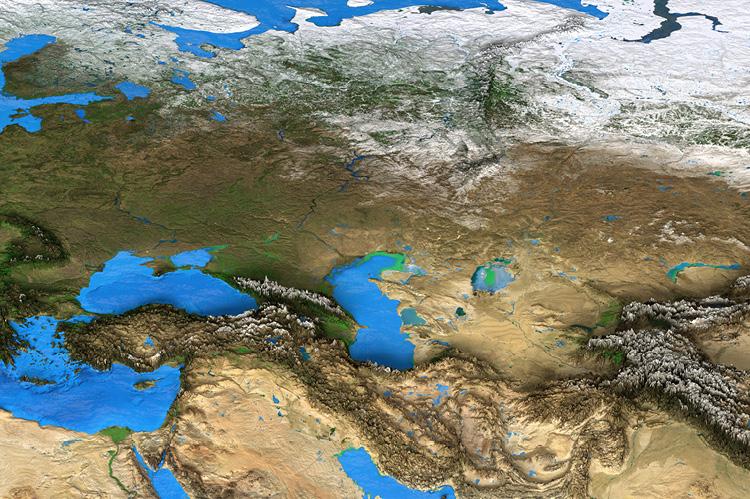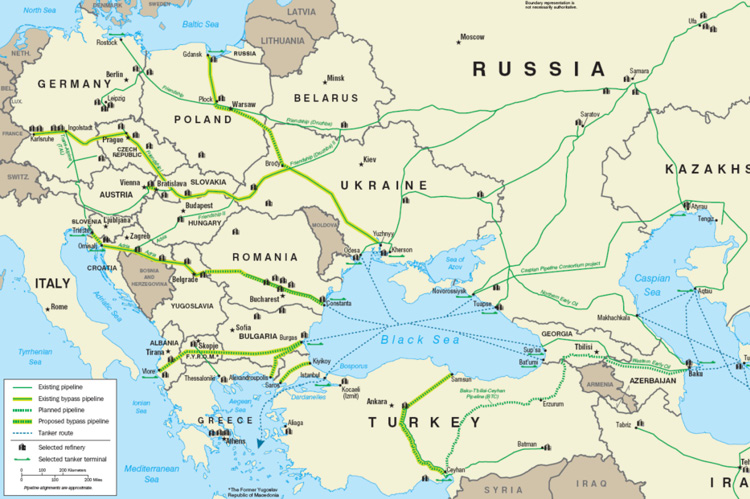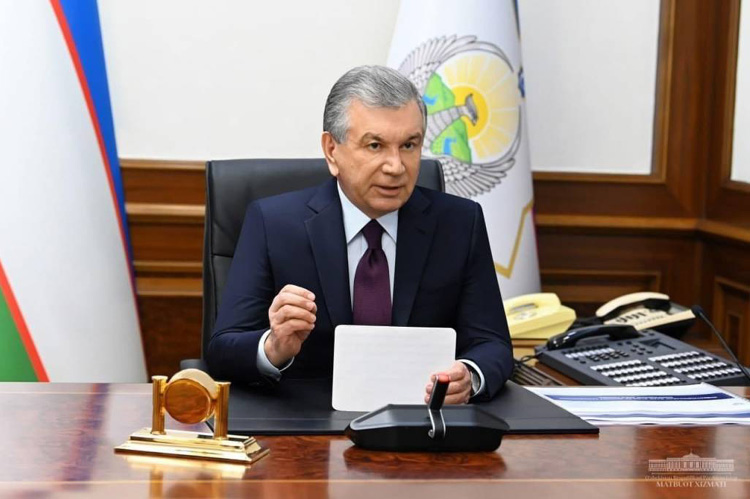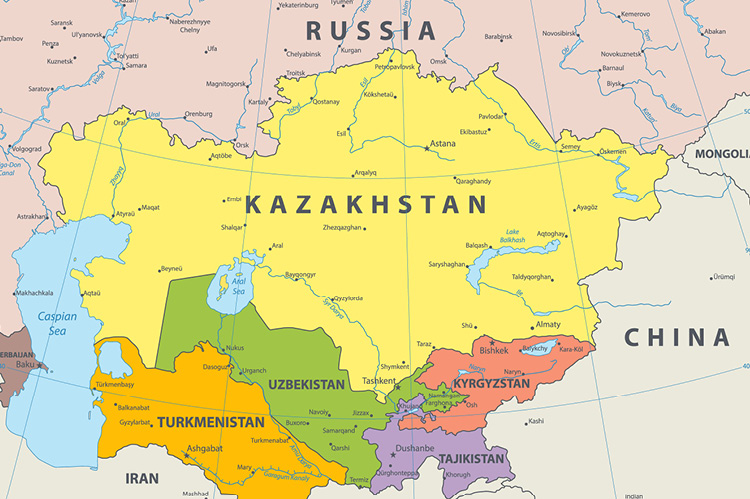Energy Markets in Central Asia: Opening Policies and Pipeline Options
The war raging in Ukraine has ushered in a new era worldwide. What seemed self-evident yesterday is being called into question today. Our author provides a brief overview of the situation in Central Asia, which is already turning since 2016, and gives an outlook of what may come.

When Vladimir Putin decided to attack Ukraine, he opened a new chapter in European history. Russia has started a war against Ukraine. This is not only a threat for Ukraine, but also for Europe as a whole, for the security of Europe.
Facing this conflict, the EU is standing together as one, together with the US. It has been long since such a scenario could be seen - if ever.
The complete change in foreign politics and the ban of energy from the East has an enormous impact on the economy in all countries in Europe, but to a different degree. Several of them are 100 % depending on gas from the east, such as Hungary. Also, Germany is highly depending on energy from eastern sources. If there is not enough energy, there are fears that economy will collapse. Therefore, the energy situation is a key issue for the economy and for each state as a whole, and energy is a key issue of security.
The battle for energy is not a battle on the ground. I does not need military actions but instead the war is taken to the economic field. As a reaction to the war in Ukraine, the USA, EU and its member states cut or at least reduce economic ties with Russia which until now delivers huge amounts of carbon fossil energy to Europe, that is not only in gas, but also coal and oil. Earnings from these businesses finance more than half of the state budget in Moscow. This cut of energy deliveries will have a strong effect, in addition to taking sanctions in the SWIFT system. But a gap was left open to leave possibilities for energy delivery payment - and there are of vital importance for Europe.
Most of the pipelines delivering energy from Russia pass Ukraine - which is in flames now.
So how will things go on?
Finding Ways to Become Independent from Russian Pipelines
It seems that Russia has built several bypasses in the past years to circumvent Ukraine. There is Nord Stream, delivering gas through the Baltic Sea, and there is Nord Stream 2, which is ready build but not being used so far, and built on the same route.

Looking at the southern routes, new pipelines appeared in the past few years. The EU had decided to build and enhance the Southern Gas Corridor, which did not happen as was the plan, but a new pipeline has been built from Baku to southern Italy, financed by Turkey and Azerbaijan, to bring Caspian gas to Europe.
Although the receiving market seems limited, two more pipelines with Russian gas have been built across the Black Sea to bring Russian gas to southeast Europe. Experts have doubts if they will be feasible. Both pipelines, Blue Stream and Turk Stream, are built through the Black Sea which is up to 3000 m deep. It is very likely, that both pipelines were rather a strategic than an economic project.
Gazprom gas was already available in Southeastern Europe, in fact it was the only source for gas, but comes via pipelines running through Ukraine. Today, deliveries to southeastern markets can continue, even if infrastructure in Ukraine was destroyed. People in Romania even have the choice: pipeline gas from Turk Stream and Blue Stream both delivering Russian gas, or pipeline gas from the Southern Gas Corridor, which brings Caspian gas from Baku, Azerbaijan.
The receiving market in Europe seems small for such great volumes coming to the European gas market. But climate change politics have led to plans with more and more renewable energy from wind power. The steady flow of wind cannot be guaranteed. For times with low wind power, coal or gas have to substitute. Coal is not desirable when low emissions are the main goal of energy politics. As a result, the demand for gas will rise, which is one reason why the EU simply declared gas supply a renewable energy through its taxonomy policy.
The Southern Gas Corridor was planned already in the 1990-ies. When Azerbaijan became an independent country, in 1991, Western energy companies took the chance to explore oil and gas resources underneath the Caspian Sea. Onshore resources were already depleted, but offshore and underneath the sea, they found great resources. Different than companies from Eastern countries, US and British companies had the technology to make use of them. They started calculating and concluded, that it was feasible to bring gas and oil from the Caspian Sea to Western markets and to Europe. Their ideas fell on fertile ground in Baku, a city renowned for its oil and gas reserves since old times.
The governments of Azerbaijan had a high interest in pumping fossil fuels to the West and to earn billions of dollars. Also, the governments of Georgia and Turkey were interested - they could earn a good share of money from transit fees. Also interested were two countries in Central Asia, Kazakhstan, and Uzbekistan, on the Eastern side of the Caspian Sea. Both have considerable amounts of gas and oil in the ground. Hopes were high, that their countries could build pipelines through the Caspian Sea and connect to the pipeline infrastructure running through the Caucasus.
Establishing a Southern Gas Corridor
The plan for building a pipeline from Baku to Europe took years until it became reality. A consortium was found, called Nabucco, with the common goal to bring Caspian gas to Europe. For years and years, the group met and made plans, but never commonly agreed on the route and the financing. After more than ten years, the consortium fell apart. But still, the wish to build a pipeline to Europe remained in Baku und Turkey. Finally, they decided to build a pipeline on their own expense. They build it with the shorter way feasible, that is from Baku in a straight line to Italy. The so-called Southern Gas Corridor was established. Today it connects the already existing pipeline from Baku to Kars, Turkey, with the newly build pipelines TANAP (Trans Anatolian pipeline) and TAP (Trans Adriatic Pipeline). It ends in southern Italy.
In contrast to Nabucco, the southern corridor does not reach the southern und middle states of Eastern Europe and it has not storages added to it, which would have been the case with Nabucco. So, comparing the two routes, Nabucco would have been the better choice for energy security of Southeastern Europe. And looking at the situation nowadays, countries like Hungary would have much less of a problem. In near future, new plans may arise to connect them to the southern route pipelines.
High dynamics in Europe due to the war in Ukraine make it exceedingly difficult to foresee the coming developments. Will there be more pipelines needed from Italy to the north? Will Azerbaijan and Turkey have talks with Europeans to enlarge the capacity of the Southern Gas Corridor?
New Developments East of the Caspian Sea
Future developments are much easier to forecast in Central Asia. A steady growth of the economies and a steady growth of their population trigger an increasing demand for energy.
Turkmenistan, Kazakhstan, and Uzbekistan have considerable amounts of natural reserves in their ground. Turkmenistan is planning to pump gas to India via TAPI, the Turkman-Afghanistan-Pakistan-India, a pipeline over 1.814 km and a capacity of up to 33 bcm per year. But it seems unclear, when the pipeline will start operating.
In past decades, oil and gas from Central Asia were mostly exported via pipelines to the North, and from there to Europe. It was good business for both sides, the producing and the selling country. But the large margin of the deal remained in Russian hands. Year after year, it financed a large share of the state budget of the Soviet Union, and later of Russia. In some peak years, the producing country received less than half for the same gas that what it was sold for t o the receiving market.
This enormous difference did not remain unseen by the producing countries. They had a high interest in selling directly to the European market, and not via Moscow and its infrastructure.
Kazakhstan was the first country to try out new routes. The black gold from its oil fields in the Caspian was shipped to Baku, from where it was pumped to Western markets - by an old, and restored pipeline from Baku to Batumi at the Black Sea, by trains on the same route, and by pipeline from Baku to Ceyhan, a Turkish harbor at the Mediterranean. This started in 2008. Meanwhile, Kazakhstan has become the fourth largest oil provider for the European market.
Kazakhstan still sends oil to Russia because its government is pursuing a multi-vectorial foreign policy. It is interested in having good relations with all neighbors.
Turkmenistan, which has the fourth largest gas reserves so far known in the world, would like to export gas and oil to Western markets as well. Small amounts of oil are sent to the West in a steady flow. Oil tankers bring oil from the eastern side of the Caspian to Baku on the western shore, where it goes to the international markets on the same routes as the oil from Azerbaijan and Kazakhstan.
A pipeline for gas, more than 3,000 km long, has been constructed from Turkmenistan to China. But the margin for Turkmenistan is small. Therefore, business with Europe remains interesting. But it lacks a pipeline through the Caspian Sea. The issue of trans-Caspian pipelines has been in the interest of Central Asia for more than 15 years, especially since the trans-Caucasian pipelines have been built and are pumping oil and gas to Western market - for much better prices for Central Asian countries than in old times. Trans-Caucasian pipelines reach western markets and they have brought wealth not only to Azerbaijan and Georgia. But they have awoken desires in Central Asia to connect to the existing pipeline system on the western shore of the Caspian. Until now, Central Asia relies heavily on selling to the north and from there to Europe.
Not only Kazakhstan and Turkmenistan, but also Uzbekistan is interested in exporting fossil fuels. It is a double land locked country in the heart of Central Asia with gas and oil in the ground, and also some coal. Already in the 1990-ies, when the new transport lines in the Caucasus were discussed, President Karimov had shown great interest. New opportunities had appeared on the horizon for the politically independent, but economically still highly dependent country.
But as time went on, it became clear, that this was not in the interest of Russia. By fighting over the legal status of the Caspian Sea, Russia and Iran blocked all plans for a pipeline through the Caspian.
A lot has happened since then. Today, more than twenty years later, the situation is different. Until 2016, Uzbekistan had isolated itself from the outside world. This meant that more than half of the population of Central Asia with about 65 million people lived under isolation. The threat of Taliban and extremist terror was always present and gave good reason to keep borders closed. No entry, no exit for its population, and extremely limited possibilities for traveling. The isolation was a heavy burden for the economic development of the country.
In Soviet times, the economy of all Soviet states, so called brother states, was built on mutual dependency. To isolate from this system was a huge challenge and led to deep economic problems until new ways were found. Uzbekistan was trying to rely on its home market and home economy.

All this changed after President Karimov had died in September 2016. His follower in office, President Mirziyoyev, had a sharp vision of what the country needed to turn things around to prosperity. His first goal was to develop good relations with all neighboring states. The second was to introduce democracy and market economy. The third was to open borders, which had been closed for very many years. With an inspiring speech to all Uzbeks, he announced a huge package of reforms to come. The country needed new dynamics, and all living there should take responsibility to bring them on the way.
Within only a few months, the President settled all long-lasting conflicts with the neighbors. One of them was that during Soviet times Uzbekistan delivered gas to Kyrgyzstan and Tajikistan, in exchange for water. After the independence, both countries wanted money in return for their deliveries, which had been for free during Soviet times. In addition, there were different ideas about the timing: In spring, the upper mountain states Tajikistan and Kyrgyzstan collected water in great reservoirs to produce electricity during later months of the year. But exactly at that time Uzbekistan as a lower country with extended steps and deserts needed a lot of water, because it is the time when farmers bring out their crops.
With the new President, a new wind started blowing and a lot of things changed in Central Asia. In October 2017 the five States of Central Asia decided to work together. The events in Ukraine in 2014 had taught them a lesson. They could witness how weak a single state was, even though it was a big state. The occupation of the two regions Donetsk and Luhansk in Eastern Ukraine and the annexation of the Krim gave the signal. All Central Asian States agreed to form a Union, which was loose, but it was a beginning that was going to lead to much closer cooperation. The EU was giving advice and consultation.
A New Economic Union in Central Asia

The Central Asian states Kazakhstan, Uzbekistan, Turkmenistan, Kyrgyzstan and Tajikistan are very different in their geographical and geological aspects, as well as in natural resources, but working together would mean to take advantage of their differences. The advantages of cooperation for Central Asia as one were overwhelming. An economic union of more than 65 million people, a young and growing population, and relative stability gave a signal to investors. Numerous reforms in Uzbekistan are an inspiring moment for new ideas and new enterprises. The Cotton Campaign, for instance, an NGO which fights child and forced labor all over the world, officially announced on March 10, 2022, that the global boycott on Uzbekistan’s cotton products would be lifted since there was no more forced or child labor any more. ILO, the International Labor Organization of the UN, confirmed their message. This sends new signals for the economy and opens new chances.
With the new Silk Road or, as it is called from the western side, or the Belt and Road initiative, the whole region has turned into a region of changes and growth. Even during Corona times, the economy in Uzbekistan is growing by 3,5 percent. The opening of the borders opened new chances, even for the Aral Sea region, where extensive usage of water in the past decades and climate change have turned 90 percent of the Sea from water to desert. The economy of the region is growing and with it the need for much for energy. There are a lot of natural resources in the ground, but they need to get to the place where they are needed. Many building activities are ahead - to transport fossil fuels for energy needs, and to transport water to where it is needed. New economic clusters have been set up to maximize the value chain in the country.
Changes will also happen in Central Asia to connect regions and economic centers. Connectivity has become the magic word for change in the region, hand in hand with the need for more energy, fossil and renewable.
Pipelines in Central Asia were directed toward the center in the north. This will have to be adjusted to new developments in Central Asia. In addition, new pipelines to the West are still a desirable option. Some of the fossil energy of Kazakhstan and Uzbekistan will be used in the region. But the countries need foreign currency, so trade and exports are a basic need for further growth. China as a close neighbor is one option, Russia is another, but Europe is a desire, on both sides.
It is still an open question, if pipelines across the Caspian Sea will bring oil and gas to Europe. But it is beyond questioning that Central Asia will need a lot more water pipelines and energy pipelines for transport. They will bring oil and gas to production centers, and with new technologies, they could bring hydrogen from wind and solar farms in the extensive steps to the economic clusters.
Growth is for sure in Central Asia, and so are many more pipelines for water, for gas and for oil.
